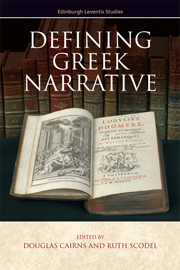Book contents
- Frontmatter
- Contents
- Preface
- Notes on Contributors
- 1 Introduction
- PART I DEFINING THE GREEK TRADITION
- PART II THE DEVELOPMENT OF THE GREEK TRADITION
- 6 Exemplarity and Narrative in the Greek Tradition
- 7 ‘Where do I begin?’: An Odyssean Narrative Strategy and its Afterlife
- 8 Some Ancient Views on Narrative, its Structure and Working
- 9 Who, Sappho?
- 10 The Creative Impact of the Occasion: Pindar's Songs for the Emmenids and Horace's Odes 1.12 and 4.2
- 11 Narrative on the Greek Tragic Stage
- 12 Stock Situations, Topoi and the Greekness of Greek Historiography
- 13 Heliodorus the Hellene
- PART III BEYOND GREECE
- Bibliography
- Index
9 - Who, Sappho?
from PART II - THE DEVELOPMENT OF THE GREEK TRADITION
Published online by Cambridge University Press: 05 September 2014
- Frontmatter
- Contents
- Preface
- Notes on Contributors
- 1 Introduction
- PART I DEFINING THE GREEK TRADITION
- PART II THE DEVELOPMENT OF THE GREEK TRADITION
- 6 Exemplarity and Narrative in the Greek Tradition
- 7 ‘Where do I begin?’: An Odyssean Narrative Strategy and its Afterlife
- 8 Some Ancient Views on Narrative, its Structure and Working
- 9 Who, Sappho?
- 10 The Creative Impact of the Occasion: Pindar's Songs for the Emmenids and Horace's Odes 1.12 and 4.2
- 11 Narrative on the Greek Tragic Stage
- 12 Stock Situations, Topoi and the Greekness of Greek Historiography
- 13 Heliodorus the Hellene
- PART III BEYOND GREECE
- Bibliography
- Index
Summary
It is clear that Sappho's poems, so far as we can reconstruct them, are not ‘narratives’ in the ordinary sense, even if we do not wish to accept the argument that lyric and narrative are naturally opposed. There is an obvious difference between the kind of story being told in Sappho fr. 94, where the speaker asks a girl who is leaving to remember their gentle pleasures together, and the extended heroic narrative of the Iliad. But how are we to frame that difference in terms of narrative? More specifically, can a poem like fr. 94 (already compromised by its incomplete state) count as narrative at all?
Perhaps the easiest place to start in considering the place of narrative in Sappho is her use of named characters from Greek mythology. There are several instances of mythological narrative in Sappho's corpus, where parts of stories might be spelled out in detail or where the simple reference to a name will be enough to set a story in motion. When Sappho mentions Helen, for example, in fr. 16, or has a messenger recount Hector's return to Troy with Andromache in fr. 44, or evokes Tithonus in the New Sappho, we know that we are firmly in the world of Greek storytelling.
- Type
- Chapter
- Information
- Defining Greek Narrative , pp. 175 - 196Publisher: Edinburgh University PressPrint publication year: 2014



